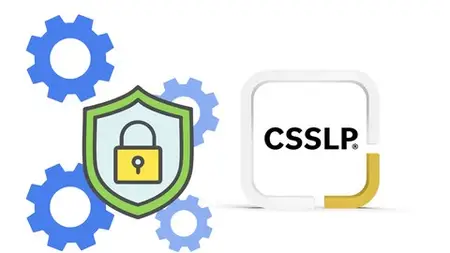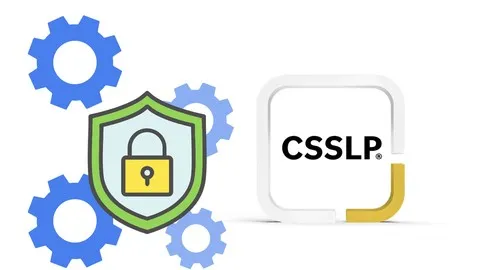Master Secure Software Development : Complete Csslp Guide
Published 9/2024
MP4 | Video: h264, 1920x1080 | Audio: AAC, 44.1 KHz
Language: English | Size: 754.47 MB | Duration: 7h 30m
Published 9/2024
MP4 | Video: h264, 1920x1080 | Audio: AAC, 44.1 KHz
Language: English | Size: 754.47 MB | Duration: 7h 30m
CSSLP Certification, includes Practice Questions and Tests, MindMaps, FlashCards & Pdf Notes
What you'll learn
Secure Software LifeCycle
Secure Software Development, Testing, Deployment etc
Prepare for CSSLP
CSSLP Readiness
Requirements
Basics Software Development experience is required
Description
Welcome to the Certified Secure Software Lifecycle Professional (CSSLP) Course! If you're involved in software development or project management, understanding how to maintain security throughout the software lifecycle is crucial. This course offers comprehensive training to help you build and manage secure software from inception to deployment.What is CSSLP? CSSLP stands for Certified Secure Software Lifecycle Professional. It's a certification provided by (ISC)² designed for professionals who integrate security practices into each phase of software development. This certification guides you through writing secure code and managing security risks effectively.Why is CSSLP Important?Career Growth and Skills Enhancement: The CSSLP certification arms you with the best practices in secure software development, significantly boosting your skills and making you invaluable in protecting software from threats.Industry Recognition: Being CSSLP certified enhances your professional credibility, allowing you to gain trust and recognition in the industry.Staying Current: The certification keeps you updated with the latest security standards and regulations, essential in the rapidly evolving tech landscape.Building Trust with Clients: With CSSLP, you demonstrate to clients that their software projects are secure and adhere to the highest standards of security practices.Who Should Take This Course? This course is tailored for various roles involved in software development and security, including:Software Architects and EngineersSoftware DevelopersApplication Security SpecialistsSoftware Program ManagersQuality Assurance TestersPenetration TestersSoftware Procurement AnalystsProject ManagersSecurity ManagersIT Directors/ManagersCourse Structure: We’ll cover everything needed to achieve the CSSLP certification, broken down into eight comprehensive domains:Secure Software Concepts: Learn about confidentiality, integrity, availability, security models, and adversaries in software security.Secure Software Requirements: Focus on functional and non-functional requirements, including security regulations and compliance.Secure Software Architecture and Design: Explore security architecture, threat modeling, and best practices in secure design.Secure Software Implementation: Discuss secure coding practices, error handling, and runtime security.Secure Software Testing: Develop security testing strategies, including penetration testing, fuzzing, and cryptographic validation.Secure Software Lifecycle Management: Examine secure configuration, version control, and software risk management.Secure Software Deployment, Operations, Maintenance: Learn about operational risk analysis, secure release practices, and ongoing security maintenance.Secure Software Supply Chain: Address software supply chain risks and supplier security requirements.Maximize Your Learning Experience:Access Rich Course Content: Engage with detailed lessons, guides, and real-world examples provided throughout the course.Interactive Learning Tools: Utilize sample questions, practice exams, mind maps, and review sessions to reinforce learning.Community Interaction: Join our discussion forums to collaborate with peers and resolve queries through community support.Continuous Review: Benefit from additional resources, appendix sections, and regular concept reviews to deepen your understanding.Guarantee: This course comes with a 30-day money-back guarantee, ensuring that your investment is completely risk-free.Start your journey to becoming a CSSLP-certified professional today and open doors to new opportunities and enhanced security expertise in your career!Welcome aboard, and let’s embark on this educational journey together!
Overview
Section 1: Introduction
Lecture 1 Introduction
Lecture 2 About Exam
Section 2: Domain-1 Secure Software Core Concepts
Lecture 3 Domain -1 Content
Section 3: Domain 1 - 1.1 Core Concepts
Lecture 4 0-Introduction
Lecture 5 1-CIA Guideline
Lecture 6 3-Authentication
Lecture 7 4-Authorization
Lecture 8 5-Accountability
Lecture 9 6-Non Repudiation
Lecture 10 7-Secure Development Lifecycle (SDL)
Lecture 11 8-SDL Components
Lecture 12 Summary and Recap
Section 4: Domain 1 - 1.2 Security Design Principles
Lecture 13 0-Introduction
Lecture 14 1-System Tenets
Lecture 15 2-Secure Design Tenets
Lecture 16 4-Adversaries
Lecture 17 Summary and Recap
Lecture 18 3-Security Models
Section 5: Domain 2 - Secure Software Requirements
Lecture 19 Domain 2 - Content
Section 6: Domain 2 - 2.1 Defining Software Requirements
Lecture 20 0.Introduction
Lecture 21 1. Functional Requirements
Lecture 22 2. Operational and deployment Requirements
Lecture 23 3. Summary and Recap
Section 7: Domain 2- 2.2 Identify and Analyze Compliance Requirements
Lecture 24 0. Introduction
Lecture 25 1. Regulations and Compliance
Lecture 26 2. Data Classification
Lecture 27 3. Privacy
Lecture 28 4. Summary and Recap
Section 8: Domain 2 - 2.3 Misuse and Abuse cases
Lecture 29 0.Introduction
Lecture 30 2. Misuse/Abuse Cases
Lecture 31 3. Requirements Traceability Matrix
Lecture 32 4. Software Acquisition
Lecture 33 5. Summary
Section 9: Secure Software Architecture and Design
Lecture 34 Secure Software Architecture and Design
Section 10: 3.1.2 Defining the Security Architecture
Lecture 35 Introduction
Lecture 36 Perform Threat Modeling
Lecture 37 Defining the Security Architecture
Lecture 38 Summary and Recap
Section 11: Quiz Assessment
Section 12: Domain 3 - 3.2 Secure Software Design
Lecture 39 Performing Architectural Risk Assessment
Lecture 40 Model (Nonfunctional) Security Properties and Constraints
Lecture 41 Model and Classify Data
Lecture 42 Evaluate and Select Reusable Secure Design
Lecture 43 Perform Security Architecture and Design Review
Lecture 44 Define Secure Operational Architecture
Lecture 45 Introduction
Lecture 46 Use Secure Architecture and Design Principles, Patterns, and Tools
Lecture 47 Performing Secure Interface Design
Lecture 48 9-Summary
Section 13: Domain 4 - Secure Software Implementation - Content
Lecture 49 Content
Section 14: Domain 4 - 4.1 Secure Coding Practices
Lecture 50 0 Intro
Lecture 51 1-Declarative vs. Imperative Security
Lecture 52 2-Memory Management
Lecture 53 3-Error Handling
Lecture 54 4-Interface Coding
Lecture 55 5-Primary Mitigation
Lecture 56 6-Learning from Past Mistakes
Lecture 57 7-Secure design principles
Lecture 58 8-Interconnectivity
Lecture 59 9-Cyrptographics Failures
Lecture 60 10-Input Validation Failuers
Lecture 61 11-General Programings Failures
Lecture 62 12-Technology Solution
Lecture 63 Summary and Recap
Section 15: Domain 4 - 4.2 Analyze Code for Security Risks
Lecture 64 0-Introduction
Lecture 65 1-Code Analysis
Lecture 66 2-Code/Peer Review
Lecture 67 3-Code Review Objectives
Lecture 68 4-Additional Sources of Vulnerability Information
Lecture 69 5-Top25
Lecture 70 6-OWASP Vulnerability
Lecture 71 7-Common Vulnerabilities
Lecture 72 8-Summary
Section 16: Domain 4 - 4.3 Implement Security Controls
Lecture 73 0-Introduction
Lecture 74 1-Security Risks
Lecture 75 2-Implement Security Controls
Lecture 76 3-Applying Security
Lecture 77 4-Anti-tampering Techniques
Lecture 78 5-Defensive Coding Techniques
Lecture 79 6-Primary Mitigations
Lecture 80 7-Secure Integration of Components
Lecture 81 8- Summary and Recap
Lecture 82 Content
Section 17: Domain 5 - 5.1 Security Test Cases
Lecture 82 Content
Lecture 83 Introduction
Lecture 84 2-Security Test Cases
Lecture 85 3-Attack Surface Evaluation
Lecture 86 4-Penetration Testing
Lecture 87 5-Common Methods
Lecture 88 6-Summary and Recap
Section 18: Domain 5 - 5.2 Security Testing Strategy and Plan
Lecture 89 0-Introduction
Lecture 90 2-Develop a Security Testing Strategy and A Plan
Lecture 91 3-Functional Security Testing
Lecture 92 4-Non Functional Security Testing - p
Lecture 93 5-Testing Techniques
Lecture 94 6-Environment
Lecture 95 7-Standards
Lecture 96 8-Crowd Sourcing
Lecture 97 9-Summary and Recap
Section 19: Domain 6 - 6.1 Secure Configuration and Version Control
Lecture 99 Content
Lecture 98 Content
Lecture 99 0 - Introduction
Lecture 100 1 - Secure Configuration and Version Control
Lecture 101 2 - Define Strategy and Roadmap
Lecture 102 3 - Manage Security Within a Software Development Met
Lecture 103 4 Identify Security Standards and Frameworks
Lecture 104 5 - Define and Develop Security Documentation
Lecture 105 6 - Develop Security Metrics
Lecture 106 7 - Decommission Software
Lecture 107 8 Report Security Status
Lecture 108 9 Summary and recap
Section 20: Domain 6 - 6.2 Software Risk Management
Lecture 109 0-Introduction
Lecture 110 1 - Incorporate Integrated Risk Management
Lecture 111 2 - Implement Continuous Improvement
Lecture 112 3 Summary and Recap
Section 21: Domain 7 - Secure Software Deployment, Operations, Maintenance
Lecture 113 Content
Section 22: Domain 7 - 7.1 Secure Software Deployment
Lecture 114 0 - Introduction
Lecture 115 2-Perform Operational Risk Analysis
Lecture 116 3-Release Software Securely
Lecture 117 4-Securely Store and Manage Secur
Lecture 118 5-Ensure Secure Installation
Lecture 119 6-Perform Post-Deployment Securit
Lecture 120 7-Summary
Section 23: 7.2 Secure Software Operations and Maintenance
Lecture 121 Introduction
Lecture 122 OSATO
Lecture 123 Perform Information Security Continuous Monitoring
Lecture 124 Support Incident Response
Lecture 125 Perform Patch Management
Lecture 126 Perform Vulnerability Management
Lecture 127 Runtime Protection
Lecture 128 Support Continuity of Operations
Lecture 129 Integrate Service Level Objectives and Service Level Agreements
Lecture 130 Summary
Section 24: Domain-8 Secure Software Supply Chain
Lecture 131 Content
Section 25: Domain 8 - 8.1 Software Supply Chain Risk Management
Lecture 132 0-Introduction
Lecture 133 1-Implement Software Supply Chain Risk Management
Lecture 134 2-Analyze Security of Third-Party Software
Lecture 135 3-Verify Pedigree and Provenance
Lecture 136 4-Summary and Recap
Section 26: Domain 8- 8.2 Supplier Security Requirements
Lecture 137 0-Introductoin
Lecture 138 1-Ensure Supplier Security Requirements in the Acquisition Process
Lecture 139 2-Support Contractual Requirements
Lecture 140 3-Summary
Section 27: Practice Tests
Software Security professionals,Software Architects and Engineers,Application Security Specialists,Software Project Managers,Software Program Managers



